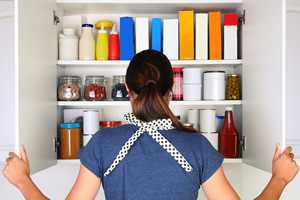Our companies are backed by the Best Pick Guarantee. Call one today!
The pantry is one of the most frequently accessed parts of a house, and as such, it can easily get out of control. Depending on the size of your pantry, you may not have room for a lot of clutter. Transform your labyrinth of pasta boxes and preserves with some of our pantry organization tips.
Take stock of what you have. The first thing you should do is empty out your pantry and sort what you already have. Organize everything by type and consider how often you use the items in question. Do you have a stockpile of canned beans that you have never used? Are there multiple opened boxes of pasta? Throw away anything that has expired or that looks suspicious, and consider donating excess canned goods to a local food bank.
Consider labels. Clearly labeling your food and the shelves of your pantry will help you organize. For food, it can help you remember how long something has been open and when something was bought or repackaged. If you’re using reusable containers like Tupperware, use masking tape and permanent marker to note when things were bought or first opened. Organizing your pantry is easier if you have labeled your shelves as well—group items by type, and mark your shelves accordingly.

Keep everything in sight. It can be tempting to fit as much onto a shelf as you can, but if you ensure that everything is visible from the front of the shelf, you’ll be less likely to bury items and forget about them. Keeping your pantry well stocked but not overstuffed is key to avoiding waste, and it will help prevent you from buying things you didn’t realize you already have.
Shelve items by frequency of use and weight. Items you use regularly should be kept in the middle of your shelves, within arm’s reach. Less commonly used items can be placed on higher or lower shelves, depending on their weight. Heavy items should be kept on lower shelves. Consider keeping a step stool nearby so that reaching items on higher shelves is easy.
Keep older items in front. Avoid ignoring older items for their newer counterparts by putting your most recently purchased items in the back of your shelves. This way, you’ll avoid having multiple open boxes of the same item, and you’ll also be less likely to accidentally let something expire without having used it.

Consider grouping items by the way you use them. Do you make a lot of meals that require certain key ingredients, like Italian or Indian food? Consider grouping the staples of these meals together in your pantry for ease of access. You can also organize by meal type—keep breakfast foods separate from snacks, condiments from cans and preserves. If you bake only occasionally, keep those products out of the way to make room for items you use every day.
Move and divide the shelves. Your pantry likely comes with standard shelving, but there’s no rule that says you have to keep it the way it came. Consider spacing shelves to your personalized needs, and use dividers and baskets to further separate your items. Clear containers in standard sizes can help you keep uneven or oddly sized products from making things look sloppy.
Ensure your pantry is serving its primary purpose. If space in your home allows, make sure your pantry only houses food and kitchen items, and keep cleaning supplies and other clutter from taking up any space within. Keeping chemicals, vacuum cleaners, brooms, and mops in a separate area of your home will ensure that your pantry’s space is being optimized for kitchen use and will also keep accidents and contaminations from happening.
By learning how to organize your pantry, you will make mealtime in your home easier and grocery shopping a breeze. With everything in sight and clearly labeled, you’ll save yourself time and money in the long run.


























